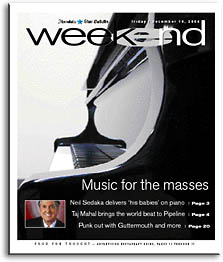
[ WEEKEND ]
Sedaka took
right path
The singer-songwriter
turned to popular music
It was 1973 and a light rain and cool temperatures enveloped Tom and Sweetie Moffatt's Nuuanu home where several dozen people gathered to say aloha to local entertainer Marlene Sai who was moving to the mainland.
Guests included some of Hawaii's most noted entertainers and a special malahini, legendary singer-songwriter Neil Sedaka, who Moffatt had first brought to Hawaii to perform in 1958.
An Acoustic Evening with Neil SedakaWhere: Hawaii TheatreWhen: 7:30 p.m. today and tomorrow Tickets: $25 to $45 Call: 528-0506
|
Sai remembers a hush descending on the room when Sedaka began singing lyrics to a song no one had heard, followed by what would become one of the most recognizable lines in pop music.
"Oooh, I hear laughter in the rain
Walking hand in hand with the one I love
Oooh, how I love the rainy days
And the happy way I feel inside"
"All of us stood there stunned," Sai said. "Poor Neil probably wondered what we were thinking. We burst into applause and cheers and yelled 'hana hou, hana hou.' "
Sedaka believes it was the first time he'd ever played "Laughter in the Rain" publicly. The song brought the musician back to the forefront of pop music after nearly a dozen years of obscurity following the British Invasion. "I do remember that hush in the room," Sedaka says. "The way they cheered gave me goose bumps, but I knew that song was going to be a hit."
The song, which climbed to number one, is Sedaka's personal favorite.
Coming from a doo wop background, yet classically trained, Sedaka has composed more than 1,000 tunes, including a dozen major pop hits he recorded himself between 1959 to 1963, with 25 million records sold, and all co-authored with Howard Greenfield, his lyricist until 1972.
In 1958, at age 18, Sedaka wrote and Connie Francis recorded "Stupid Cupid." She also sang the theme song Neil and Howie had written for the 1960 MGM classic, "Where the Boys Are."
Sedaka soon recorded his own songs, Brill Building classics like "The Diary," "Oh! Carol," "Stairway to Heaven," (not the Led Zeppelin warhorse!) "Calendar Girl," "Little Devil," "Happy Birthday, Sweet Sixteen," "Next Door to an Angel," and "Breaking Up Is Hard to Do."

Neil Sedaka planned to be a concert pianist and teacher but got into writing and singing instead.
"I had planned to be a concert pianist and teacher," Sedaka says. "But by that time, I was in high school, I was very into popular music and started writing songs to lyrics with Howie."
"Being a concert pianist is good for the soul, but not the pocketbook."
Mom and dad were "very upset" with their son's new musical direction.
"They told me I had to prove to them I could make it in popular music," Sedaka said. "They gave me six months off from Juilliard." Mom eventually came around.
"She was thrilled when I gave her a mink stole and that, for a Jewish mother, is the ultimate," Sedaka said. "I remember she used to open up the windows in their Brooklyn apartment and yell out 'Yoo hoo, Mrs. Schwartz! Neil is on the radio singing 'Oh Carol,' so turn it on.' "
And people are still listening to Sedaka, who performs about 100 concerts a year.
"My concerts are very intimate," Sedaka says. "It's only me and the piano. I do the songs the way they were written and I talk about why I wrote them, how I wrote them. Connecting with the audience shows a performer's human side."
Sedaka calls his music "my babies."
"I never let my babies get stale," he said. "I sing them in their entirety, never in a medley."
The musician cites several reasons why his songs remain timeless after more than a half century.
"In the Brill Building, I was taught to write catchy melodies, hooks, memorable lyrics, melodic songs that touched the heart," Sedaka says. "And they're all in a very good vocal range, which is why I've gotten so many cover records over the years. I write them at the piano in a comfortable vocal range."
Several artists have recorded his songs, including Tom Jones with "Puppet Man," The Fifth Dimension with "Workin' on a Groovy Thing," and the Monkees with "When Love Comes Knocking At Your Door."

A young Neil Sedaka in the heyday of his Brill Building songwriting.
Sedaka remains one of the good guys in music, with not even a hint of scandal in his life. He's been married to his wife Leba, also his manager, for 42 years.
"I was a very disciplined piano student, and knew I was in this for the long haul," he says. "I did everything in moderation. I never relied on props or funny clothes or funny glasses; it was all about the music."
His only indulgence in the early days was buying a new car every year.
"My first one was a 1958 white Chevy Impala convertible with red interior," he said. "Oh, I was hot stuff."
His inspiration still comes from listening to other vocalists and songs.
"If you listen to 'Love Will Keep Us Together' very carefully, you'll hear it's a combination of Diana Ross, Al Green and the Beach Boys," said Sedaka who describes songwriting as a "masochistic process." "You have a tune in your subconscience and you have to destroy it and rewrite it in your own, original way.
"Artists must suffer in their lives to be able to write with conviction; you have to go through some tragedy.
"Maybe that's why it took me 30 years to come up with 'Laughter in the Rain.' "
[News] [Business] [Features] [Sports] [Editorial] [Do It Electric!]
[Classified Ads] [Search] [Subscribe] [Info] [Letter to Editor]
[Feedback]
